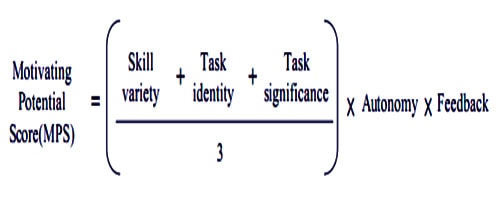Developed by J. Richard Hackman and Greg Oldham. The job characteristics model (JCM) proposes that any job can be described in terms of five core job dimensions:
- Skill variety: Skill variety is the degree to which a job requires a variety of different activities so the worker can use a number of different skills and talent. For instance, an example of a job scoring high on skill variety would be the job of an owner-operator of a garage who does electrical repairs, rebuilds engines, does body work. and interacts with customers. A job scoring low on this dimension would be the job of a body shop worker who sprays paint 8 hours a day.
- Task identity: Task identity is the degree to which a job requires completion of a whole and identifiable piece of work. An example of a job scoring high on identity would be the job of a cabinetmaker who designs a piece of furniture, selects the wood, builds the object. and finishes it to perfection. A job scoring low on this dimension would be the job of a worker in a furniture factory who operates a lathe solely to make table legs.
- Task significance: Task significance is the degree to which a job has a substantial impact on the lives or work of other people. An example of a job scoring high on significance would be the job of a nurse handling the diverse needs of patients in a hospital intensive care unit. A job scoring low on this dimension would be the job of a janitor sweeping floors in a hospital.
- Autonomy: Autonomy is the degree to which a job provides substantial freedom, independence, and discretion to the individual in scheduling the work and in determining the procedures to be used in carrying it out. An example of a job scoring high on autonomy is the job of a salesperson who schedules his or her own work each day and decides on the most effective sales approach for each customer without supervision. A job scoring low or this dimension would be the job of a salesperson who is given a set of lead,’ each day and is required to follow a standardized sales script with each potential customer.
- Feedback: Feedback is the degree to which carrying out the work activities required by job results in the individual obtaining direct and clear information about the effectiveness of his or her performance. An example of a job with high feedback is the job of a factory worker who assembles iPods and tests them to see if they operate properly. A job scoring low on feedback would be the job of a factory worker who, after assembling an iPod, required to route it to a quality-control inspector who tests it for proper operation and makes needed
The core dimensions can be combined into a single predictive index, called the motivating potential score (MPS), which is calculated as follows:

Jobs that are high on motivating potential must be high on at least one of the three factors that lead to experienced meaningfulness, and they must be high on both autonomy and feedback. If jobs score high on motivating potential, the model predicts that motivation, performance, and satisfaction will be positively affected and that the likelihood of absence and turnover will be reduced.
The JCM has been well researched. And most of the evidence supports the general framework of the theory—that is, there is a set of job characteristics, and these characteristics affect behavioral outcomes. But it appears that the MPS model doesn’t work—that is, we can better derive motivating potential by adding the characteristics rather than using the complex MPS formula. Beyond employee growth-need strength, other variables, such as the employee’s perception of his or her workload compared With that of others, may also moderate the link between the core job dimensions and personal and work outcomes. Overall, though, it appears that jobs that have the intrinsic elements of variety, identity, significance, autonomy, and feedback are more satisfying and generate higher performance from people than jobs that lack these characteristics.










